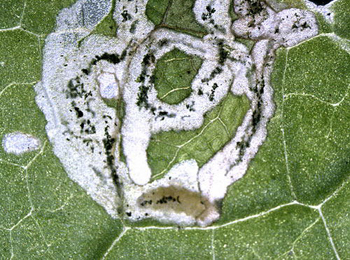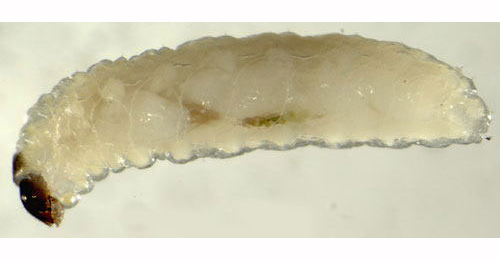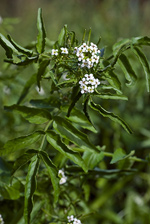|
||||||
|
NASTURTIUM. Water-cresses. [Brassicaceae] |
|
|
Two species and one hybrid of Nasturtium are recorded in Britain. These include Water-cress (N. officinale) and Narrow-fruited Water-cress (N. microphyllum). The BSBI provide a downloadable plant crib for Brassicaceae. Six British miners are recorded on Nasturtium. A key to the European miners recorded on Rorippa including Nasturtium is provided in Bladmineerders van Europa.
|
|
|
Key for the identification of the known mines of British |
|
1# > ? Leaf-miner: Details of mine unknown. |
|
|
Hydrellia meigeni Zatwarnicki, 1988 [Ephydridae]. |
|
1# > ? Leaf-miner: Details of mine unknown. |
|
|
Hydrellia ranunculi Haliday, 1839 [Diptera: Ephydridae]. |
|
1a > Leaf-miner: Irregular mine, locally shallow, elsewhere much deeper, giving it a mottled appearance. In broadleaved plants the mine often begins as a blotch with stellate extensions, but sometimes as a very fine, shallow corridor. In grasses the mine often begins in the leaf sheath. The frass is very fine-grained, initially scattered, later in aggregates. The egg is deposited on the plant surface, and the empty egg shell remains visible. But the larvae are able to leave their mine and restart elsewhere, thus mines without an egg shell can be found as well. The larva also leaves the mine before pupation. Pupation takes place in a newly made, small, blotch mine without frass; this mine may be made in another plant (species). |
 Mine of Hydrellia griseola on Glyceria fluitans Image: © Willem Ellis (Bladmineerders van Europa) |
|
|
Hydrellia griseola (Fallén, 1813) [Diptera: Ephydridae]. |
|
1b > Leaf-miner: Corridor-blotch mine, normally dorsal; usually whitish; in small leaves it lies characteristically in the centre of the leaf often touching the petiole; in larger leaves it lies to one side of the mid-rib. Frass deposited in green clumps near the leaf margin. Pupation usually external, sometimes in a separate pupation mine. Oviposition whitin the leaf, at the lower surface. The first part of the mine is a long, sometimes very long, corridor, that mostly will be overrun by the later developments. Generally this corridor is directed, frequently guided by a thick vein, to the midrib. The next section of the mine is large, irregular blotch overlying the basal section of the midrib. Locally large chunks of midrib tissue are consumed. From this central blotch excursions are made into the leaf blade: generally upper-surface, less often lower-surface and locally full-depth. In plants with narrow leaves, like Diplotaxis, the mine may occupy the entire width of the leaf. Often several larvae together in a mine. Frass blackish green, powdery, in clouds, sometimes along the sides of the corridors, later more in the periphery of the mine and in the end of extensions of the blotch, sometimes seemingly absent. (Often the frass can only be seen after the mine has been opened). Pupation generally in the ground, rarely within he leaf, in a short mine without frass. Hendel (1928a) described the biology, larva and puparium. An initial narrow gallery then leads to a blotch on the midrib of the leaf. Watch a video of a scaptomyzid fly larva on Arabidopsis on YouTube by mash92587. |
|
|
Scaptomyza flava (Fallén, 1823) [Diptera: Drosophilidae]. |
|
1c > Leaf-miner: The mine starts as a long, narrow, winding corridor running towards the midrib, widening to a blotch. Usually upper-surface, but in small leaves also full-depth parts may occur. The blotch has broad lobes; in their ends most frass is accumulated in the form of green patches or clouds. Sometimes several larvae share mine. Pupation usually in the soil, less often in the leaf (and then generally not in the mine itself but in a small separated mine, that may even be made in the petiole). |
 Mine of Scaptomyza graminum on Cerastium glomeratum Image: © Jean-Yves Baugnée (Bladmineerders van Europa) |
|
|
Scaptomyza graminum (Fallén, 1823) [Diptera: Drosophilidae]. |
|
1d > Leaf-miner: Rather small, untidy, full depth, often branched corridor, often close to the leaf margin. Sides irregularly eaten out. Frass in a greyish-green central line that is interrupted from time to time, sometimes partly in strings. In times of rain the frass may run out and appear greenish. Usually several mines in a leaf. The body is whitish; head greyish brown with Y-shaped lighter marking. Pronotum with a pair of brownish shields. The mandibles have two teeth. |
 Mine of Ceutorhynchus minutus on Raphanus sativus Image: © Willem Ellis (Bladmineerders van Europa) |
 Ceutorhynchus minutus larva, lateral Image: © Willem Ellis (Bladmineerders van Europa) |
|
|
Ceutorhynchus minutus (Marsham, 1802) [Coleoptera: Curculionidae]. |
|
|
||
| Last updated 06-Jul-2019 Brian Pitkin | ||
|
|
||

